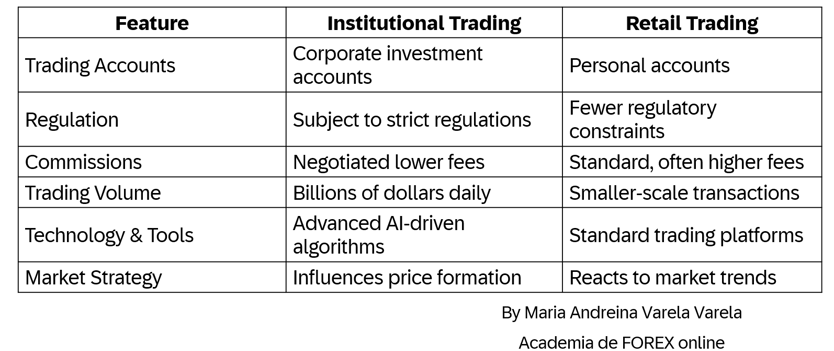Institutional Trading: How Market Giants Shape the Financial Landscape
Institutional trading plays a key role in financial markets, moving vast amounts of capital and setting trends that impact all market participants. But what sets it apart from retail trading, and how do institutional strategies influence asset prices? In this article, we’ll explore the fundamentals of institutional trading, its key differences from retail trading, and the strategies that drive the decisions of major financial players.
INSTITUTIONAL TRADING


Institutional trading refers to the buying and selling of financial assets by large entities such as banks, hedge funds, pension funds, and insurance companies. Unlike retail traders, these institutions manage massive amounts of capital, giving them distinct strategic and operational advantages.
According to financial market data, over 70% of daily transactions in major stock markets are executed by institutional traders. These large-scale operations influence asset prices, shape market trends, and create opportunities for other investors.
This article will explain how institutional trading works, how it differs from retail trading, and the core strategies these market giants use to gain an edge.
How Does Institutional Trading Work?
Institutional traders operate with specialized teams of analysts and traders who make decisions based on in-depth technical and fundamental analysis. They leverage tools such as:
✔️ Advanced trading platforms
✔️ High-frequency trading algorithms
✔️ Access to real-time market analysis and exclusive data
These advantages allow them to execute trades efficiently and at lower costs, capitalizing on their trading volume and negotiation power with brokers and exchanges.
Key Differences Between Institutional and Retail Trading
The following table highlights the major differences between institutional and retail trading:
Retail traders can benefit from understanding how institutions operate since many retail strategies attempt to follow institutional moves and anticipate their decisions.
Top Strategies Used in Institutional Trading
Institutional traders utilize various strategies to maximize returns and minimize risk. Some of the most common include:
1. Fundamental Analysis:
Institutional traders assess economic, political, and financial factors that impact asset prices over the long term. Reports on employment, interest rate decisions, and corporate earnings are key drivers of their investment decisions.
2. Asset Accumulation & Distribution:
Institutional traders accumulate large amounts of assets during periods of low volatility, creating an accumulation phase. They then distribute positions strategically to influence prices favorably.
3. Transaction Volume Analysis:
Volume is a critical indicator for institutional traders. A sudden spike in volume can indicate institutional entry or exit in a specific asset, providing crucial signals for other traders.
4. Liquidity Management:
Institutions prioritize high-liquidity markets to execute large trades without significantly affecting prices. This is why they often trade highly liquid indices and major forex pairs.
The Impact of Institutional Trading on Financial Markets
Due to the size of their trades, institutional traders have a significant impact on the markets. Some key effects include:
Trend Formation – Large institutional trades can create lasting price movements.
Increased Market Liquidity – Their high trading volumes ensure market stability.
Improved Technical Analysis Accuracy – Institutional trades leave identifiable patterns, which retail traders can analyze to anticipate movements.
For retail traders, understanding how these institutions operate is crucial for improving their strategies and spotting major shifts in the market.
Conclusion:
Institutional trading is the driving force behind modern financial markets. Their strategies, advanced tools, and high negotiation power give them a competitive edge, influencing price formation and overall market trends.
For retail traders, learning about institutional investor behavior can provide an advantage when executing trades, allowing them to track institutional movements and make more informed decisions.
If you want to take your trading to the next level, I recommend studying institutional volume analysis, liquidity management, and fundamental analysis.
#InstitutionalTrading #Investing #Trading #FinancialMarkets #TechnicalAnalysis #InvestmentStrategies #StockMarket #ProfessionalTrading #MariaAndreinaVarelaVarela


